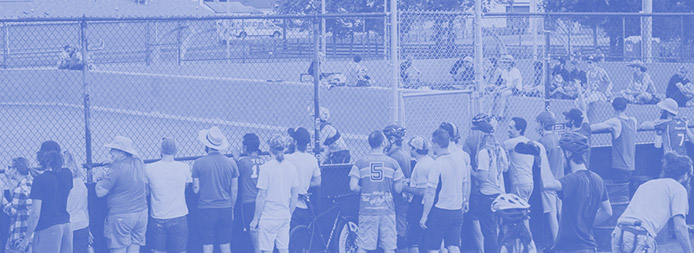Conduct on the court at the WHBPC 2017
The NAHBPA along with our host club, Lexington Bike Polo are doing many things to make this year’s WHBPC a wonderful and memorable experience for all attendees.
As part of our efforts to make the experience as enjoyable as possible for players, volunteers, and spectators, we will be actively encouraging players to steer clear of unsportsmanlike conduct. Excessive protest of referee decisions, general disruptions of game proceedings, and verbal and/or physical assault (both on and off the court) will not be tolerated throughout the week.
The NAH will be advising all referees to treat rules §6.7 & §7.2 with firm and immediate action. On the court this means immediate penalties and personal game misconduct penalties. Off the court this could lead to game suspension for players and removal from the event facility for spectators and volunteers. The NAH will also reserve the right to review player conduct by request of the head referee, a member of the NAH, or the opposing team captain following a match. Post match reviews could lead to further suspension. Players will be notified by the NAH and the Referee at the start of the game whether they are to immediately serve an escalated Game Misconduct penalty or could be subject to one during that game. These escalations will follow a player for the duration of the tournament.
Below you can find the full text for §6.7 & §7.2. We encourage all players to review the entire 2017 ruleset prior to WHBPC 2017. We look forward to having you all and we expect everyone to play and spectate in accordance with these simple rules, and treat one another with decency and respect.
– NAH & Lexington Bike Polo
https://nahbpa.gitbooks.io/nah-ruleset-2017
- §6.7 – Personal Misconduct
- §6.7.1 – Physical aggression or verbal abuse as defined in §7.2 is subject to an automatic Personal Misconduct penalty.
- §6.7.2 – If necessary, the Referee immediately stops game play to end an altercation. The penalty is assessed per §1.1.9.3. Possession goes to the fouled team and the game restarts according to §4.2.3 with the following modifications:
- §6.7.2.1 – The offending player is removed from the court for 5 minutes, 10 minutes, or the remainder of the game – at the discretion of the Referee.
- §6.7.2.2 – On the first offense, their team continues play with 2 players on the court for 30 seconds – the duration of a minor penalty – before a third player can enter play. On subsequent offenses, their team continues play with 2 players on the court for 2 minutes – the duration of a major penalty – before a third player can enter play.
- §6.7.3 – Prior offenses and the impact of the infraction on the course of play will determine the severity of the penalty for both the player and their team. If a team receives multiple severe Personal Misconduct penalties in one game, the Referee stops the game immediately and the penalized team forfeits the game. The offending team is subject to tournament ejection based on review by the tournament organizers and head Referee. The final scoreline is determined by the head Referee.
- §7.2 – Unsportsmanlike Conduct
- §7.2.1 – An unsportsmanlike conduct penalty is assessed when a player is judged by the Referee to be behaving in an unsportsmanlike manner. Examples of this include, but are not limited to:
- §7.2.1.1 – General disruption of game proceedings or excessive protest of Referee’s decisions.
- §7.2.1.2 – Verbal or physical assault of a Referee, Goal Judge, Timekeeper, Scorekeeper, Event Organizer, Spectator, or any other Player on the court.
- §7.2.1.2.1 – This is automatically assessed as Personal Misconduct per §6.7.
- §7.2.1.3 – Relocating an opponent’s dropped mallet in order to make it more difficult for them to recover per §9.6.
- §7.2.1.4 – Failure to tap-in or leave the play after dabbing.
- §7.2.2 – This penalty is assessed as a Minor, Major or Personal Misconduct at the Referees discretion, except in §7.2.1.2.
- §7.2.1 – An unsportsmanlike conduct penalty is assessed when a player is judged by the Referee to be behaving in an unsportsmanlike manner. Examples of this include, but are not limited to:


